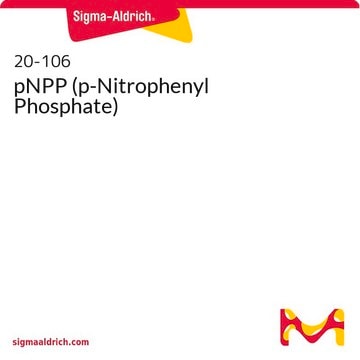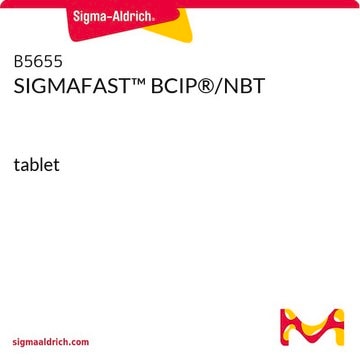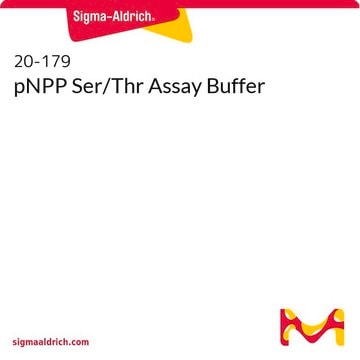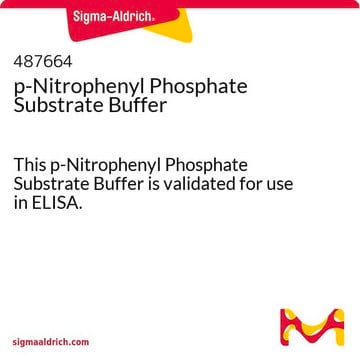P7998
Alkaline Phosphatase Yellow
alkaline phosphatase substrate, chromogenic liquid
Synonym(s):
Alkaline phosphatase substrate solution (pNPP)
Sign Into View Organizational & Contract Pricing
All Photos(1)
About This Item
UNSPSC Code:
12352204
eCl@ss:
42010105
NACRES:
NA.83
Recommended Products
Product Name
Alkaline Phosphatase Yellow (pNPP) Liquid Substrate System for ELISA, ready to use solution
Quality Level
form
liquid
storage temp.
2-8°C
General description
The product is ready to use buffered alkaline phosphatase substrate consist of p-nitrophenylphosphate (pNPP). This is the advanced substrate system contains insoluble stabilizer that enhances the stability and reactivity as well as reduces the base-line absorption. It produces a soluble end product, hence not recommended for blotting or histochemistry applications.
Application
Develops a soluble yellow reaction product that may be read at 405 nm. For endpoint assays, the reaction may be stopped with 3 N NaOH. Recommended for ELISA (microwell) procedures; not recommended for membrane applications.
Caution
Stable at least one year at 2-8 °C.
Physical form
Ready to use
Preparation Note
Contains p-nitrophenyl phosphate, a substrate for alkaline phosphatase.
Signal Word
Danger
Hazard Statements
Precautionary Statements
Hazard Classifications
Eye Dam. 1 - Skin Irrit. 2 - STOT RE 2
Storage Class Code
10 - Combustible liquids
WGK
WGK 3
Flash Point(F)
Not applicable
Flash Point(C)
Not applicable
Choose from one of the most recent versions:
Certificates of Analysis (COA)
Lot/Batch Number
Don't see the Right Version?
If you require a particular version, you can look up a specific certificate by the Lot or Batch number.
Already Own This Product?
Find documentation for the products that you have recently purchased in the Document Library.
Customers Also Viewed
Cristina A Teixeira et al.
Clinical science (London, England : 1979), 130(18), 1665-1675 (2016-07-08)
Transthyretin (TTR)-related amyloidoses are diseases characterized by extracellular deposition of amyloid fibrils and aggregates in tissues composed of insoluble misfolded TTR that becomes toxic. Previous studies have demonstrated the ability of small compounds in preventing and reversing TTR V30M deposition
Laura C Jacques et al.
Nature communications, 11(1), 1892-1892 (2020-04-22)
Streptococcus pneumoniae serotype 1 is the predominant cause of invasive pneumococcal disease in sub-Saharan Africa, but the mechanism behind its increased invasiveness is not well understood. Here, we use mouse models of lung infection to identify virulence factors associated with
Baoxin Wang et al.
Experimental and therapeutic medicine, 13(1), 178-186 (2017-01-27)
Damage to the recurrent laryngeal nerve often causes hoarseness, dyspnea, dysphagia, and sometimes asphyxia due to vocal cord paralysis which result in a reduction of quality of life. Brain-derived neurotrophic factor (BDNF) and glial cell line-derived neurotrophic factor (GDNF) play
Yuval Ramot et al.
Toxicologic pathology, 49(7), 1255-1268 (2021-09-09)
COVID-19 is a rapidly spreading disease, posing a huge hazard to global health. The plasmid vaccine pTK1A-TPA-SpikeA (named COVID-eVax) encodes the severe acute respiratory syndrome coronavirus 2 S protein receptor-binding domain, developed for intramuscular injection followed by electroporation (EP). The
E Galikowska et al.
European journal of clinical microbiology & infectious diseases : official publication of the European Society of Clinical Microbiology, 30(9), 1067-1073 (2011-02-15)
The use of bacteriophages, instead of antibodies, in the ELISA-based detection of bacterial strains was tested. This procedure appeared to be efficient, and specific strains of Salmonella enterica and Escherichia coli could be detected. The sensitivity of the assay was
Our team of scientists has experience in all areas of research including Life Science, Material Science, Chemical Synthesis, Chromatography, Analytical and many others.
Contact Technical Service











